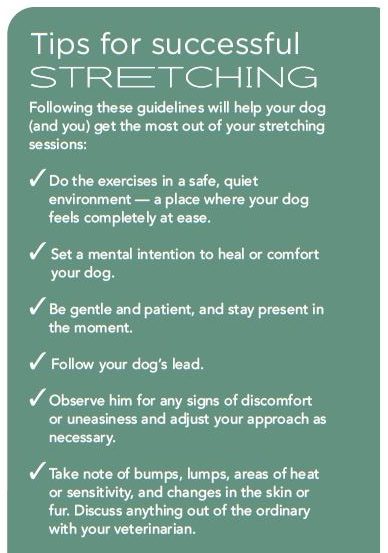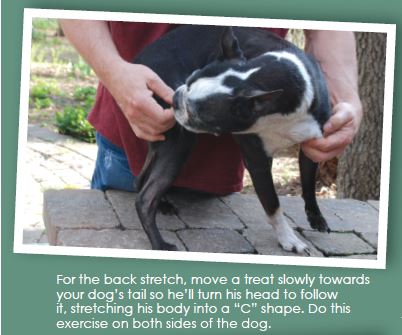4 simple stretches for dogs

Help keep your dog limber with these gentle stretches.
Give yourself a stretch. Notice how good it feels, and how it helps you feel more relaxed and supple. Your dog can benefit from stretching too. In fact, gentle stretching exercises are a wonderful way to improve his well-being, whether he’s an athlete, senior citizen, a giant breed, or just deserving of some extra attention (and what dog isn’t?).
- Dogs who are getting up in years are prone to joint problems, muscle loss, decreased flexibility, and the aches and pains of an aging body. Stretching can help alleviate these issues.
- If your dog is an athlete – especially in a strenuous sport like flyball or agility – he’s putting stress on his body whenever he competes. Stretching is extremely beneficial for him.
- Large and giant breeds typically have more musculoskeletal problems than smaller dogs, so keeping your big guy or gal lean, strong and supple with stretches will serve him well throughout his life.
You can keep him flexible
Conventional veterinary medicine doesn’t have much to offer dogs with sore bodies beyond drugs and surgery, and these treatments are typically attempted only after a problem has developed and the animal’s mobility and quality of life are compromised. That’s why natural therapies like stretching, regular physical activity and chiropractic are so important to maintaining your dog’s comfort and flexibility, no matter what his age or activity level.
All it takes is a few minutes a day to help your dog preserve and even improve his mobility and range of motion – and prevent or alleviate pain. The key is to do it consistently. Daily walks followed by a short session of gentle stretching are a great way to keep him limber and conditioned for a lifetime.
For most of these stretches, it’s best if your dog is standing.
Focus on the hips, shoulders and back
Stretching is especially beneficial for three areas of your dog’s body – the hips, shoulders and back. The following stretches, done slowly and gently, are well tolerated by most dogs. If you don’t feel confident in your ability to do these stretches, consider asking your veterinarian or a veterinary chiropractor to demonstrate them for you so you can do them at home.
 For most of these stretches, it’s best if your dog is standing, but you can also do them when he’s lying on her side, or in the case of the chest stretch, on his back. Needless to say, if he shows any sign of pain during stretching, discontinue the movement and have her seen by your vet or rehab therapist as soon as possible to determine where the pain is coming from.
For most of these stretches, it’s best if your dog is standing, but you can also do them when he’s lying on her side, or in the case of the chest stretch, on his back. Needless to say, if he shows any sign of pain during stretching, discontinue the movement and have her seen by your vet or rehab therapist as soon as possible to determine where the pain is coming from.
1. Stretching the hip flexors
The hip flexors are muscles that allow your dog to move his legs and hips while walking, trotting or running. To stretch the hip flexors, ask your dog to stand, and grasp a back leg above the knee. Gently and slowly move the leg back straight out behind your dog’s body. When you reach a point of resistance, where further extension would require applying pressure, hold the leg in position for 15 to 30 seconds. Repeat this stretch two or three times with each back leg.
 Benefits your dog will receive from this stretch include increased movement and flexibility in the hips and spine, improved conditioning of the lower back, hip and leg muscles, and a reduction in arthritis-related discomfort and pain.
Benefits your dog will receive from this stretch include increased movement and flexibility in the hips and spine, improved conditioning of the lower back, hip and leg muscles, and a reduction in arthritis-related discomfort and pain.
2. Stretching the shoulder flexors
Shoulder flexors enable smooth movement and proper use of your dog’s front legs. To stretch them, have your dog stand and grasp a front leg above the elbow. Place your other hand under the elbow to stabilize it, and gently move the leg forward (imagine you’re teaching your dog do a “high five”). At the point of resistance, hold the position for 15 to 30 seconds and repeat two or three times with each front leg.
 Not only does this stretch improve the integrity of the dog’s shoulder structure, it also benefits the wrists and elbows, and increases his breathing capacity by loosening his chest muscles.
Not only does this stretch improve the integrity of the dog’s shoulder structure, it also benefits the wrists and elbows, and increases his breathing capacity by loosening his chest muscles.
3. Stretching the back
This stretch requires a few training treats. With your dog standing, position yourself to one side of her and move the treat slowly in the direction of her tail, encouraging her to follow it with her eyes – turning only her head. This will require her to bend her body into a “C” shape. Hold her in this position for 15 to 30 seconds, then step to her other side and repeat the exercise. Do two or three stretches on each side.
 After you’ve stretched your dog’s back, he’ll really enjoy a sacrum and back rub. The sacrum is the area in front of the base of the tail, between the hipbones. Using light pressure and circular movements, massage the hard flat surface of the sacrum. Move your hands slowly up your dog’s spine and back, using gentle massage strokes. Regular sacrum and back rubs decrease anxiety, increase the flow of spinal fluid, enhance mobility in the hips and spine, and help bring your dog’s body into balance.
After you’ve stretched your dog’s back, he’ll really enjoy a sacrum and back rub. The sacrum is the area in front of the base of the tail, between the hipbones. Using light pressure and circular movements, massage the hard flat surface of the sacrum. Move your hands slowly up your dog’s spine and back, using gentle massage strokes. Regular sacrum and back rubs decrease anxiety, increase the flow of spinal fluid, enhance mobility in the hips and spine, and help bring your dog’s body into balance.
 4. Stretching the chest
4. Stretching the chest
Here’s one more stretch to try. The muscles in your dog’s chest undergo a great deal of strain from day to day. This exercise is called an abduction stretch, meaning a stretch away from center. With your dog standing, grasp one front leg near the wrist and gently open it out to the side. Hold for several seconds and release. Repeat with the other front leg.
You can also do this stretch while your dog is lying on his back, if he is comfortable doing so. Grasp both front legs near the wrists and gently open them out to the side. Hold for several seconds, release and repeat. Since your dog may also expect a chest or tummy rub (he’s on his back, after all!), you can relax him further by giving a gentle chest massage using light pressure and circular strokes.
Regular stretching not only helps keep your dog’s muscles supple and flexible; it also boosts circulation, increases oxygenation and hydration, produces a calm and contented feeling, and enhances the bond you share with him.




